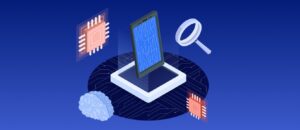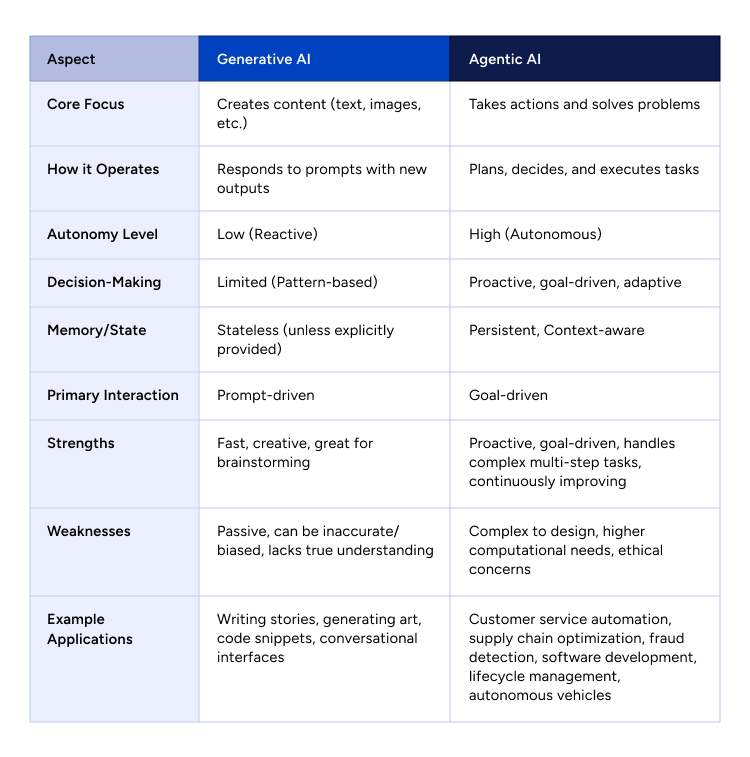What is Agentic AI and how will it transform work?



As Deloitte’s CEO Jason Girzadas states, “we are entering the autonomous enterprise era where agents can transform work and business models, ushering in entirely new ways of working”.
This vision points to Agentic AI, a new wave of AI that moves beyond content generation to autonomously execute tasks and make decisions. This shift is about to revolutionize industries by optimizing processes, enhancing customer interactions, and strengthening cybersecurity.
The demand for truly autonomous intelligence is accelerating, with the global AI agents market projected to grow at a staggering CAGR of 45.1% from 2024 to 2030. Business leaders are taking note: Deloitte’s 2025 enterprise AI survey found that 52% of executives named Agentic AI as one of the most interesting emerging areas, even ahead of many Generative AI applications.
In this article, we will explore what is agentic ai, how it will transform work, and how to best implement it in your organization.
Agentic AI vs. Generative AI: A Paradigm Shift in Capabilities
To understand what agentic AI is and its transformative potential, it’s essential to distinguish it from Generative AI (GenAI). Both leverage large language models (LLMs), but they differ fundamentally in architecture, interaction, and autonomy.
Defining Agentic AI: Autonomy, Goal-Orientation, Adaptability
Agentic AI systems are characterized by:
- Autonomous Operation: They function independently, making real-time decisions without constant human input.
- Goal-Oriented Behavior: Designed with specific objectives, they plan and work toward achieving complex goals with minimal supervision.
- Adaptability & Continuous Learning: They dynamically adjust strategies based on changing environments and continuously refine performance.
- Reasoning and Decision-Making: They weigh options, anticipate outcomes, and change plans in complex situations.
The operational framework typically involves Perception, Decision-making, Execution, and Learning and Adaptation.
Contrasting with Generative AI: Content Creation, Prompt-Dependency
To understand what agentic AI is, it is crucial to understand the differences from generative AI and LLMs. Generative AI specializes in creating new content (text, images, music, or code) by learning from data patterns. It is primarily input-driven and reactive, triggered by user prompts, and generally lacks internal states or persistent memory.
Agentic AI represents a qualitative leap from creation to action and autonomous problem-solving. While GenAI uses LLMs for content, Agentic AI leverages them as a reasoning engine to orchestrate multi-agent collaboration and dynamic task decomposition. The most robust enterprise AI solutions will combine them synergistically.
For example, GenAI could create marketing materials, while Agentic AI determines optimal pricing and advertising channels, or a conversational agent uses GenAI for responses but an Agentic layer to escalate issues.
The following table provides a comparative overview:

Transforming Workflows and Empowering Decision-Making
Automating Complex, Multi-Step Business Processes
Agentic AI excels in automating workflows, significantly reducing manual intervention.
- IT & Customer Support: Power Design’s "HelpBot" autonomously handles IT requests like password resets, freeing over 1,000 hours of IT staff capacity. AI agents can analyze sentiment, review history, and formulate personalized resolutions in real time, enabling even junior reps to provide expert-level service.
- Supply Chain Management: An Agentic AI can detect supply disruptions and "orchestrate the entire workflow" of finding alternatives, checking suppliers, comparing prices, rerouting shipments, and updating production schedules.
- Consulting and Knowledge Work: Firms like Deloitte ("Zora AI") and EY ("EY.ai Agentic Platform") have launched proprietary Agentic AI platforms that function as "digital team members,” replicating top consultants’ capabilities across geographies and time zones.
These applications demonstrate Agentic AI’s ability to orchestrate and optimize end-to-end processes across departments, necessitating deep integration across an organization’s technological infrastructure.
Enhancing Real-time Decision-Making
Agentic AI dynamically evaluates options and selects the most effective path, continuously refining its approach based on real-time feedback.
- In healthcare, AI-powered diagnostic systems prioritize patient treatments based on real-time data analysis.
- In manufacturing, predictive maintenance agents monitor equipment performance to forecast failures and schedule preemptive repairs.
- In finance, JPMorgan uses Agentic AI for real-time fraud detection, preventing billions in potential losses annually.
By autonomously allocating resources and adjusting strategies, Agentic AI reduces operational costs and allows human experts to focus on higher-value tasks. This shift to autonomous decision-making in critical areas necessitates robust frameworks for trust, transparency, and human oversight.
Reshaping Digital Teams: IT, Product, and the Blurring Lines
Agentic AI fundamentally restructures organizational roles and requires a re-evaluation of core competencies across IT and product functions.
IT and Product Development
Agentic AI profoundly impacts IT operations and the software development lifecycle (SDLC).
- IT Operations & Support: Agentic AI automates routine IT tasks like password resets. It can also integrate with enterprise systems to diagnose and resolve complex technical issues, continuously learning from interactions. An AI agent can dynamically adapt to troubleshoot novel error patterns and apply fixes without human intervention.
- Software Development Lifecycle (SDLC): Agentic AI automates repetitive coding and testing, enhances collaboration, and provides predictive insights. AI copilots can generate 20–35% of a developer’s code with acceptable quality. Agentic systems can also generate requirements, draft design documents, write test cases, and update documentation automatically. Gartner predicts that by 2028, one-third of enterprise application software will incorporate Agentic AI capabilities natively.
Evolving Roles for Data Professionals
Agentic AI significantly reshapes the roles of data engineers, data scientists, and data analysts, shifting their focus toward more strategic responsibilities.
- Data Engineers: Roles will shift from routine tasks to designing overall data architectures and managing platforms for performance and governance.
- Data Scientists: Focus will redefine from solving predefined problems to proactively framing complex business challenges, requiring deeper business understanding and upskilling in Agentic AI frameworks.
- Data Analysts: Agentic AI enhances their productivity by automating tasks and accelerating insight generation, making their role in ensuring a strong data foundation even more critical.
This indicates that organizations must invest heavily in upskilling and reskilling programs and redefine career pathways to adapt to these new hybrid human-AI teams.
Convergence of Functions: The Blurring Boundaries
Agentic AI profoundly blurs the lines between traditional roles, particularly between Product Managers (PMs) and Engineers.
- Product Managers and Engineers: AI enables PMs to get more deeply involved in building AI software through prompt engineering, using English as a "programming language" to directly influence AI application logic. Concurrently, AI coding tools automate technical coding tasks, pushing engineers toward more product design and management roles.
- Product Management Redefined: The PM role is shifting from "feature-centric" to "outcome-centric", focusing on "how do we get the task done with minimal input?" This means less emphasis on UI and more on API design, integration depth, and trust. Emerging hybrid roles like “AI Agent Product Manager” and “AI Agent Engineer” are expected to bridge strategic objectives with technical implementation. This convergence could mean reorganizing teams around end-to-end outcomes rather than by function.
Agentic AI ultimately frees up human resources from repetitive tasks, allowing them to focus on higher-value, strategic work, fostering creativity and innovation.
Strategic Integration and Adoption: Paving the Way for Agentic Enterprise
Successfully integrating Agentic AI at scale requires a strategic, holistic approach.
Best Practices for Successful Implementation
Organizations must adopt a multi-level strategy that aligns organizational structures and workforce readiness.
- Holistic Approach: Successful transformation requires aligning strategy, capabilities, ethical standards, and workforce development, not just technology.
- Identify High-Impact Use Cases: Start with clearly defined, repeatable, high-volume tasks with clear rules and defined business outcomes, such as HR automation or IT incident triage. CIOs note that significant ROI often comes from automating specific micro-workflows that deliver quick wins.
- Engage Stakeholders Early: Crucial for success, ensuring leaders are aligned and employees understand how AI will support them.
- Define Goals, Not Just Tasks: Agentic AI operates toward goals, requiring implementation plans to frame success in terms of outcomes rather than simple step-by-step tasks.
- Focus on Integration: Agents must seamlessly pull and write data to source systems (HRIS, CRM, ERP) and trigger workflows using APIs.
The Imperative of "Human-in-the-Loop" (HITL)
Autonomy in Agentic AI does not mean a complete lack of oversight. Maintaining human-in-the-loop (HITL) controls is a best practice that ensures human judgment is applied where it matters most, protecting against errors and building trust. Clear escalation protocols are essential for high-stakes outcomes. For example, an AI might prepare options or recommendations for human sign-off. Organizations should consider “co-pilot” modes initially, allowing staff to observe and learn from AI behavior before scaling autonomy.
Addressing Technical Readiness
Robust technical foundations are a prerequisite for Agentic AI, including strong data architecture, reliable API connectivity, and robust cloud infrastructure. Disconnected data is a major hurdle, hindering legacy modernization efforts for 83% of organizations. Integrating Agentic AI with existing legacy systems often requires substantial investment and specialized expertise, taking between 12 to 18 months. A phased approach, starting with pilots and gradually scaling up, is recommended.
Successful Agentic AI adoption is less about technology and more about organizational change management, leadership alignment, and fostering human-AI collaboration.
Navigating the Future: Challenges and Responsible AI Governance
Despite its immense potential, Agentic AI deployment introduces several significant challenges.
Key Challenges in Agentic AI Deployment
- ROI Assessment: Difficult to quantify due to unclear benchmarks and indirect benefits.
- Ethical Goal-Setting & Bias: Aligning AI with diverse social morals and mitigating biases from training data is complex.
- Security Risks: Autonomous systems are vulnerable to cyberattacks.
- Accountability: Determining responsibility when autonomous systems make decisions with unforeseen consequences is a major challenge.
- Transparency/Explainability: The "black box" problem hinders trust and accountability.
- Regulatory Compliance: AI regulations are constantly changing, requiring adaptive governance.
- Job Displacement: Potential to replace certain roles necessitates careful workforce planning.
The convergence of these challenges with rapid adoption creates an urgent imperative for proactive, self-regulating AI governance.
The Pillars of Effective Agentic AI Governance
Effective AI governance frameworks are built upon three critical, interconnected pillars:
- Data Governance: Ensures AI systems are trained on high-quality, unbiased datasets and adhere to ethical, regulatory, and legal standards, including monitoring data lineage and compliance with privacy laws.
- Algorithmic Controls: Provides technical oversight for monitoring, refining, and adapting AI systems throughout their lifecycle, including ethical review boards and regular audits.
- Human-AI Alignment: Ensures AI systems reflect human values and societal norms, crucial for preventing unintended consequences as AI becomes more autonomous.
Organizations should approach Agentic AI governance strategically by assessing their current AI maturity, implementing AI-driven governance policies, investing in audit and monitoring tools, and establishing incident response protocols.
The emphasis on “human-in-the-loop” and “human-AI alignment” suggests that the future of Agentic AI is about intelligent augmentation and a symbiotic relationship between human and machine, rather than full automation.
Conclusion: Seizing the Agentic Advantage
Agentic AI represents a profound evolution in artificial intelligence, moving beyond content generation to autonomous decision-making and action. This emerging technology is poised to fundamentally reshape work, transform digital teams, and empower strategic decision-making across the enterprise.
Early movers who strategically plan and invest in Agentic AI will gain a significant competitive advantage. To seize this agentic advantage, organizations must embrace a holistic approach that prioritizes:
- Strategic Clarity: Identify high-impact use cases aligned with clear business outcomes, starting small, and validating value before scaling.
- Organizational Readiness: Invest in comprehensive workforce upskilling, redefine job roles to emphasize human creativity, and foster a culture of human-AI collaboration.
- Robust Governance: Implement comprehensive data governance, algorithmic controls, and human-AI alignment frameworks to ensure ethical, transparent, and secure deployment, including clear human-in-the-loop protocols.
- Iterative Implementation: Adopt a phased approach, starting with contained use cases, continuously monitoring outcomes, and refining models based on real-time feedback.
If you need help in implementing these changes, Consultport provides access to top-tier independent AI consultants who can help you bridge the gap between strategy and execution.
on a weekly basis.

